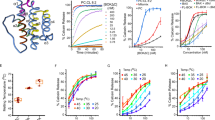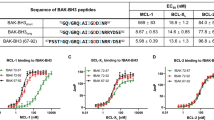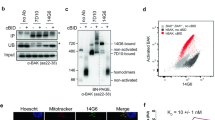Abstract
BOK/MTD was discovered as a protein that binds to the anti-apoptotic Bcl-2 family member MCL-1 and shares extensive amino-acid sequence similarity to BAX and BAK, which are essential for the effector phase of apoptosis. Therefore, and on the basis of its reported expression pattern, BOK is thought to function in a BAX/BAK-like pro-apoptotic manner in female reproductive tissues. In order to determine the function of BOK, we examined its expression in diverse tissues and investigated the consequences of its loss in Bok−/− mice. We confirmed that Bok mRNA is prominently expressed in the ovaries and uterus, but also observed that it is present at readily detectable levels in several other tissues such as the brain and myeloid cells. Bok−/− mice were produced at the expected Mendelian ratio, appeared outwardly normal and proved fertile. Histological examination revealed that major organs in Bok−/− mice displayed no morphological aberrations. Although several human cancers have somatically acquired copy number loss of the Bok gene and BOK is expressed in B lymphoid cells, we found that its deficiency did not accelerate lymphoma development in Eμ-Myc transgenic mice. Collectively, these results indicate that Bok may have a role that largely overlaps with that of other members of the Bcl-2 family, or may have a function restricted to specific stress stimuli and/or tissues.
Similar content being viewed by others
Log in or create a free account to read this content
Gain free access to this article, as well as selected content from this journal and more on nature.com
or
Abbreviations
- APC:
-
allophycocyanin
- ATP5a1:
-
ATP synthase H+ transporting mitochondrial F1 complex alpha subunit 1
- bp:
-
basepair
- BM:
-
bone marrow
- cDNA:
-
complementary deoxyribonucleic acid
- CC:
-
corpus callosum
- Ctx:
-
cerebral cortex
- ddCT:
-
delta-delta CT
- DMEM:
-
Dulbecco's modified Eagle medium
- DNA:
-
deoxyribonucleic acid
- EDTA:
-
ethylenediaminetetraacetic acid
- ESC:
-
embryonic stem cells
- FACS:
-
fluorescence activated cell sorting
- FCS:
-
fetal calf serum
- FITC:
-
fluorescein isothiocyanate
- FasL:
-
Fas ligand
- GAPDH:
-
glyceraldehyde 3-phosphate dehydrogenase
- h:
-
hour
- HCl:
-
hydrochloric acid
- HIF1α:
-
hypoxia-inducible factor 1 α subunit
- LN:
-
lymph nodes
- mac:
-
macrophages
- neu:
-
neutrophils
- mg:
-
milligram
- μg:
-
microgram
- mL:
-
milliliter
- μL:
-
microlitre
- mM:
-
millimolar
- kDa:
-
kilo Dalton
- MOMP:
-
mitochondrial outer membrane permeabilisation
- mRNA:
-
messenger ribonucleic acid
- NaCl:
-
sodium chloride
- PI:
-
propidium iodide
- qPCR:
-
quantitative polymerase chain reaction
- R-PE:
-
red phycoerythrin
- SCNA:
-
somatically acquired copy number alterations
- SD:
-
standard deviation
- SDS-PAGE:
-
sodium dodecyl sulphate polyacrylamide gel electrophoresis
- SEM:
-
standard error of the mean
- Se:
-
septum
- sIg:
-
surface immunoglobulin
- Str:
-
Striatum
- SV40:
-
simian virus 40
- Ter119+ cells:
-
erythroid cells expressing the Ter119 lineage marker
- WBC:
-
white blood cells
- wt:
-
wild-type
References
Youle RJ, Strasser A . The BCL-2 protein family: opposing activities that mediate cell death. Nat Rev Mol Cell Biol 2008; 9: 47–59.
Chipuk JE, Green DR . How do BCL-2 proteins induce mitochondrial outer membrane permeabilization? Trends Cell Biol 2008; 18: 157–164.
Huang DCS, Strasser A . BH3-only proteins – essential initiators of apoptotic cell death. Cell 2000; 103: 839–842.
Letai AG . Diagnosing and exploiting cancer's addiction to blocks in apoptosis. Nat Rev Cancer 2008; 8: 121–132.
Willis SN, Fletcher JI, Kaufmann T, van Delft MF, Chen L, Czabotar PE et al. Apoptosis initiated when BH3 ligands engage multiple Bcl-2 homologs, not Bax or Bak. Science 2007; 315: 856–859.
Merino D, Giam M, Hughes PD, Siggs OM, Heger K, O’Reilly LA et al. The role of BH3-only protein Bim extends beyond inhibiting Bcl-2-like prosurvival proteins. J Cell Biol 2009; 186: 355–362.
Lindsten T, Ross AJ, King A, Zong W, Rathmell JC, Shiels HA et al. The combined functions of proapoptotic Bcl-2 family members Bak and Bax are essential for normal development of multiple tissues. Mol Cell 2000; 6: 1389–1399.
Rathmell JC, Lindsten T, Zong W-X, Cinalli RM, Thompson CB . Deficiency in Bak and Bax perturbs thymic selection and lymphoid homeostasis. Nat Immunol 2002; 3: 932–939.
Zong WX, Lindsten T, Ross AJ, MacGregor GR, Thompson CB . BH3-only proteins that bind pro-survival Bcl-2 family members fail to induce apoptosis in the absence of Bax and Bak. Genes Dev 2001; 15: 1481–1486.
Cheng EH, Wei MC, Weiler S, Flavell RA, Mak TW, Lindsten T et al. BCL-2, BCL-xL sequester BH3 domain-only molecules preventing BAX- and BAK-mediated mitochondrial apoptosis. Mol Cell 2001; 8: 705–711.
Strasser A, Harris AW, Huang DCS, Krammer PH, Cory S . Bcl-2 and Fas/APO-1 regulate distinct pathways to lymphocyte apoptosis. EMBO J 1995; 14: 6136–6147.
Hsu SY, Kaipia A, McGee E, Lomeli M, Hsueh AJW . Bok is a pro-apoptotic Bcl-2 protein with restricted expression in reproductive tissues and heterodimerizes with selective anti-apoptotic Bcl-2 family members. Proc Natl Acad Sci USA 1997; 94: 12401–12406.
Hsu SY, Hsueh AJW . A splicing variant of the Bcl-2 member Bok with a truncated BH3 domain induces apoptosis but does not dimerize with antiapoptotic Bcl-2 proteins in vitro. J Biol Chem 1998; 273: 30139–30146.
Inohara N, Ekhterae D, Garcia I, Carrio R, Merino J, Merry A et al. Mtd, a novel Bcl-2 family member activates apoptosis in the absence of heterodimerization with Bcl-2 and Bcl-xL . J Biol Chem 1998; 273: 8705–8710.
Ray JE, Garcia J, Jurisicova A, Caniggia I . Mtd/Bok takes a swing: proapoptotic Mtd/Bok regulates trophoblast cell proliferation during human placental development and in preeclampsia. Cell Death Differ 2010; 17: 846–859.
Soleymanlou N, Wu Y, Wang JX, Todros T, Ietta F, Jurisicova A et al. A novel Mtd splice isoform is responsible for trophoblast cell death in pre-eclampsia. Cell Death Differ 2005; 12: 441–452.
Beroukhim R, Mermel C, Porter D, Wei G, Raychaudhuri S, Donovan J et al. The landscape of somatic copy-number alteration across human cancers. Nature 2010; 463: 899–905.
Deckwerth TL, Elliott JL, Knudson CM, Johnson Jr EM, Snider WD, Korsmeyer SJ . BAX is required for neuronal death after trophic factor deprivation and during development. Neuron 1996; 17: 401–411.
Bouillet P, Metcalf D, Huang DCS, Tarlinton DM, Kay TWH, Köntgen F et al. Proapoptotic Bcl-2 relative Bim required for certain apoptotic responses, leukocyte homeostasis, and to preclude autoimmunity. Science 1999; 286: 1735–1738.
Villunger A, Michalak EM, Coultas L, Müllauer F, Böck G, Ausserlechner MJ et al. p53- and drug-induced apoptotic responses mediated by BH3-only proteins Puma and Noxa. Science 2003; 302: 1036–1038.
Eischen CM, Roussel MF, Korsmeyer SJ, Cleveland JL . Bax loss impairs Myc-induced apoptosis and circumvents the selection of p53 mutations during Myc-mediated lymphomagenesis. Mol Cell Biol 2001; 21: 7653–7662.
Egle A, Harris AW, Bouillet P, Cory S . Bim is a suppressor of Myc-induced mouse B cell leukemia. Proc Natl Acad Sci USA 2004; 101: 6164–6169.
Hemann MT, Zilfou JT, Zhao Z, Burgess DJ, Hannon GJ, Lowe SW . Suppression of tumorigenesis by the p53 target PUMA. Proc Natl Acad Sci USA 2004; 101: 9333–9338.
Garrison SP, Jeffers JR, Yang C, Nilsson JA, Hall MA, Rehg JE et al. Selection against PUMA gene expression in Myc-driven B-cell lymphomagenesis. Mol Cell Biol 2008; 28: 5391–5402.
Michalak EM, Jansen ES, Happo L, Cragg MS, Tai L, Smyth GK et al. Puma and to a lesser extent Noxa are suppressors of Myc-induced lymphomagenesis. Cell Death Differ 2009; 16: 684–696.
Adams JM, Harris AW, Pinkert CA, Corcoran LM, Alexander WS, Cory S et al. The c-myc oncogene driven by immunoglobulin enhancers induces lymphoid malignancy in transgenic mice. Nature 1985; 318: 533–538.
Knudson CM, Tung KSK, Tourtellotte WG, Brown GAJ, Korsmeyer SJ . Bax-deficient mice with lymphoid hyperplasia and male germ cell death. Science 1995; 270: 96–99.
Hotchkiss RS, Strasser A, McDunn JE, Swanson PE . Cell death. N Engl J Med 2009; 361: 1570–1583.
Degterev A, Yuan J . Expansion and evolution of cell death programmes. Nat Rev Mol Cell Biol 2008; 9: 378–390.
Gao S, Fu W, Durrenberger M, De Geyter C, Zhang H . Membrane translocation and oligomerization of hBok are triggered in response to apoptotic stimuli and Bnip3. Cell Mol Life Sci 2005; 62: 1015–1024.
Yin CY, Knudson CM, Korsmeyer SJ, Van Dyke T . Bax suppresses tumorigenesis and stimulates apoptosis in vivo. Nature 1997; 385: 637–640.
Shibata MA, Liu ML, Knudson MC, Shibata E, Yoshidome K, Bandey T et al. Haploid loss of bax leads to accelerated mammary tumor development in C3(1)/SV40-TAg transgenic mice: reduction in protective apoptotic response at the preneoplastic stage. EMBO J 1999; 18: 2692–2701.
Schwenk F, Baron U, Rajewsky K . A cre-transgenic mouse strain for the ubiquitous deletion of loxP-flanked gene segments including deletion in germ cells. Nucleic Acids Res 1995; 23: 5080–5081.
Livak KJ, Schmittgen TD . Analysis of relative gene expression data using real-time quantitative PCR and the 2(-Delta Delta C(T)) Method. Methods 2001; 25: 402–408.
Acknowledgements
We thank Drs JM Adams, S Cory, DCS Huang, D Gray, M Herold and G Kelly for mice, reagents and advice; K Vella, G Siciliano, D Cooper, N Iannarella and J Coughlin for animal care; J Corbin for automated blood analysis; B Helbert and C Young for genotyping; E Tsui for histological preparations; Dr. F Battye and his team for cell sorting; D Quilici, T Nikolaou and G Thomas for irradiation and D Bachmann for expert technical assistance. This work was supported by grants and fellowships from the Leukemia Research Foundation (to FK), the National Health and Medical Research Council (Program Grant no. 461221, NHMRC Australia Fellowship), the NIH (CA43540), the Leukemia and Lymphoma Society (SCOR grant no. 7413), the Swiss National Science Foundation (to TK, PP0033_119203) and operational infrastructure grants through the Australian Government IRISS and the Victorian State Government OIS.
Author information
Authors and Affiliations
Corresponding author
Ethics declarations
Competing interests
The authors declare no conflict of interest.
Additional information
Edited by C Borner
Supplementary Information accompanies the paper on Cell Death and Differentiation website
Rights and permissions
About this article
Cite this article
Ke, F., Voss, A., Kerr, J. et al. BCL-2 family member BOK is widely expressed but its loss has only minimal impact in mice. Cell Death Differ 19, 915–925 (2012). https://doi.org/10.1038/cdd.2011.210
Received:
Revised:
Accepted:
Published:
Issue date:
DOI: https://doi.org/10.1038/cdd.2011.210
Keywords
This article is cited by
-
Targeting the apoptosis pathway to treat tumours of the paediatric nervous system
Cell Death & Disease (2022)
-
Glucocorticoids can induce BIM to trigger apoptosis in the absence of BAX and BAK1
Cell Death & Disease (2020)
-
Modeling the function of BAX and BAK in early human brain development using iPSC-derived systems
Cell Death & Disease (2020)
-
Bok regulates mitochondrial fusion and morphology
Cell Death & Differentiation (2019)
-
BOK promotes erythropoiesis in a mouse model of myelodysplastic syndrome
Annals of Hematology (2019)



